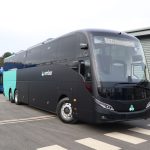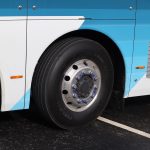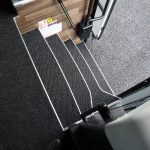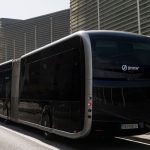Pelican Bus and Coach unveiled the long-anticipated Yutong GTe14 battery-electric tri-axle on 28 February. The dealership says that the GTe14 opens further parts of the coach market to zero-emission, with discussions already underway with several potential buyers.
The GTe14 is 13.97m long and seats a maximum of 61. Pelican says that its introduction follows industry feedback calling for a larger zero-emission coach than the established two-axle TCe12, with capacity for more passengers and luggage and an extended range.
A demonstrator GTe14 will enter service with National Express on 7 March between London and Stansted Airport. In addition, production examples for scheduled service provider Ember have arrived as part of an order for 14 such examples for use in Scotland.
The Ember fleet is currently the only confirmed deal for the GTe14. However, Pelican is talking with other interested parties in both the retail market and the scheduled service landscape.

Surprise debut of the demonstrator with National Express comes as the operator considers its future position on zero-emission in coach. It tried a TCe12 in 2020, and in January confirmed that it has a hydrogen fuel cell-electric prototype in build at Caetano, although scant details of that vehicle have been shared.
When used between London and Stansted, the GTe14 will be charged via temporary provision at the airport. Stansted is described by National Express New Vehicles Director Richard Ball as being “very positive and cooperative” about the trial.
While the necessary infrastructure is temporary, provider Zenobe Energy has developed what Mr Ball says is an innovative solution to leverage the extent of power available. It utilises a pack of former battery-electric bus batteries that charge at a constant rate of around 40kW. When the coach is plugged in between trips, it can then draw power at 140kW.
NatEx thoughts on coach future sit well with Yutong GTe14
Should battery-electric be deployed on a permanent basis by National Express, Mr Ball says that the operator would look to charge at 300kW. That line of thought sits well with the GTe14.

Pelican Managing Director Richard Crump has outlined charging options for the vehicle. In basic format, that is at up to 150kW via an air-cooled CCS2 connector. Also possible will be up to 300kW via two of those units. A further option is a single input of up to 300kW with liquid cooling; the ultimate may become two of the latter to give a cumulative 600kW peak power draw.
Perhaps surprisingly, Yutong representatives have confirmed that a 600kW charging rate will impact neither battery life nor warranty. The vehicle manufacturer says that it can finely control the input to maintain energy storage durability. Yutong does not expect to develop pantograph-based replenishment for the GTe14, although it is not ruled out entirely.
On a simpler level, Pelican offers portable lower-power chargers for its battery-electric products that can work from the 63A, three-phase power found in most workshops. “If you have a rolling road, you have enough power to run one of those,” says Mr Crump.
Fitted as standard to the GTe14 is a rear-view camera monitoring system (CMS) and a ‘bird’s eye view’ display. It also has an electric handbrake. Pelican believes that the CMS matches the GTe14’s cutting-edge image; the cameras will also benefit energy consumption by at least 2% via lower air resistance compared to conventional mirrors.
The demonstrator has 563kW/h of energy storage. Also available is 422kW/h, with 621kW/h to follow in 2025. It is expected that the maximum capacity may increase further in the future, but that is reliant on greater energy density rather than additional installed batteries.

While 61 passenger seats are possible, the demonstrator has 53 for now. That takes account of an offside centre area that is laid out for a wheelchair user to achieve PSVAR compliance, although for when accessibility is not required, an ‘infill’ is provided to raise that space to the same level as the floor beneath fixed seats, allowing an additional four positions.
Lift at large centre door; internal fit-out to a high standard
Wheelchair user access where provided is not via a typical half-height door. Instead, the GTe14 comes with a full-height nearside centre opening similar to that on the TCe12. It is 1,100mm wide, and the lift is within the bottom step. When activated, the platform rises in an arc motion to dock within the coach into the gangway.
The GTe14 will come as standard with the wide centre door, and not be available with an offside continental opening. The sunken toilet is thus on the nearside.
Fitted to the demonstrator is a D’Hollandia 500kg SWL lift installed in China, but subsequent accessible examples will get Hidral Gobel units after arrival in the UK. Other elements of the specification are wireless, USB and 240v charging points.

A high standard Yutong passenger seat is also fitted. It comes with vertically adjustable headrests, magazine nets, and a drop-down table, among other comforts.
Pelican UK Coach Sales Manager Simon Collins observes that retail buyers currently discussing the GTe14 are generally those that have already taken the TCe12. “The new coach shows that a move to the next stage for battery-electric is largely straightforward; many people will see the transition from the TCe12 to the GTe14 as a relatively easy step,” he observes.
Yutong GTe14 to lead Pelican’s work on coach during 2024
The benefit of Pelican having a GTe14 demonstrator is clear. It will run with National Express for a month and return to Pelican in time for display at the UK Coach Rally on 12-13 April. Demonstrations will then continue. Another GTe14 will be shown at Euro Bus Expo at the NEC Birmingham on 12-13 November.

Mr Ball adds that key to the National Express test is understanding energy consumption. “We will get solid data during the demonstration,” he notes, adding that drivers will be trained to enable the return of maximum efficiency.
National Express has a strong programme of that tuition on its battery-electric bus fleet in the West Midlands, and a selected team of drivers at Stansted will receive the same training ahead of the demonstrator entering service there.
Meanwhile for Pelican, arrival of the GTe14 is a further expansion of its Yutong coach and bus range. Yutong attained fifth position in UK market share figures for 2023, registering 237 new coaches and buses here last year. Pelican is bold enough to say that with a fair wind, it could exceed 400 units in 2024.
Mr Crump notes that the GTe14 will largely generate new business rather than abstract it from other models; the same is true for the U11DD battery-electric double-decker bus. As conclusion of the first decade of Yutong’s presence in the UK approaches, things look ever more positive for the brand here.
Further details of developments for Yutong in the UK, including the GTe14, will follow in the March issue of routeone.
Click on any of the following images to expand:

































